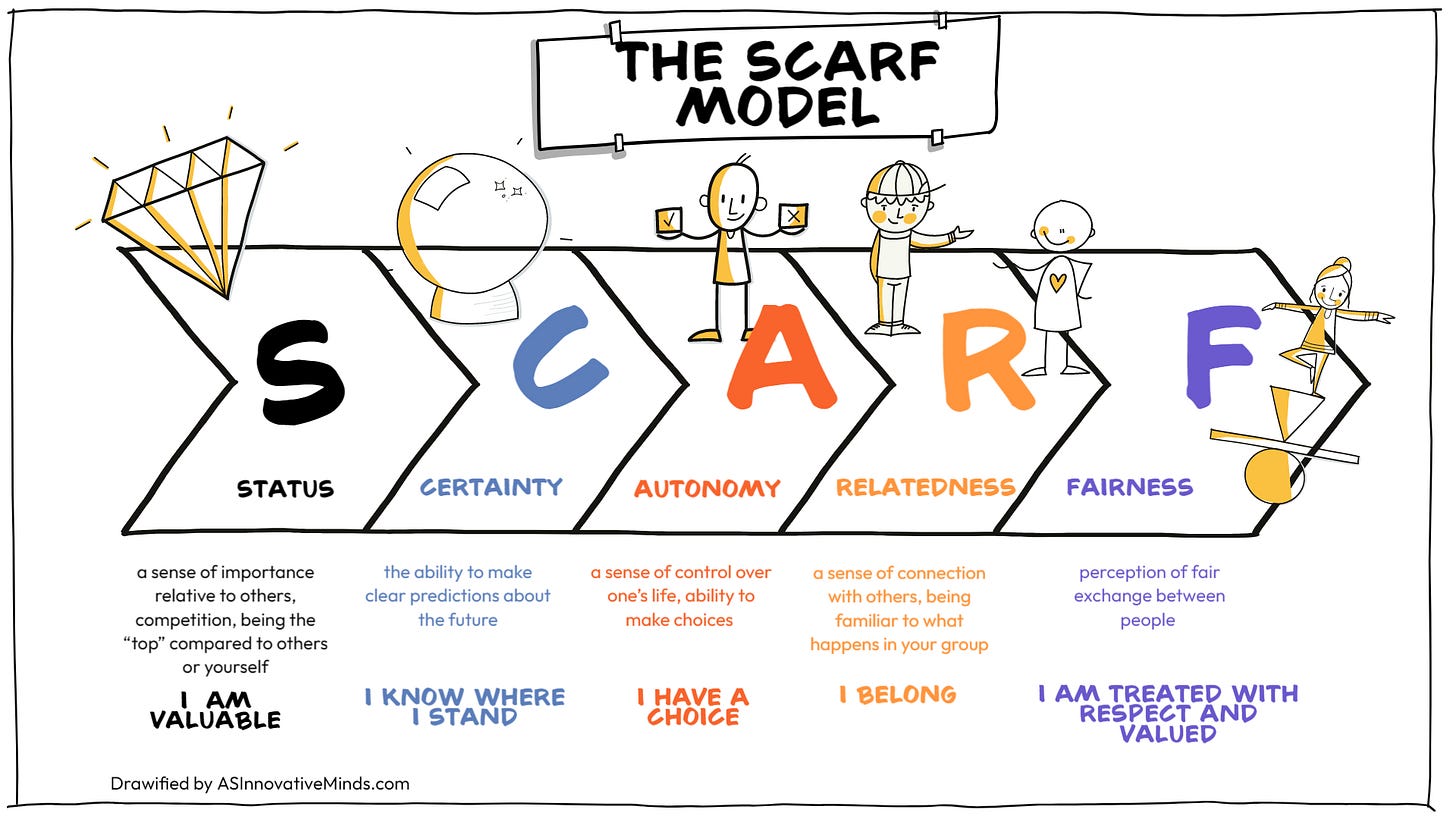5 Buttons To Upgrade Your Interactions With Any Person
The Universal SCARF Model And Its Benefits Across Cultures and Industries
Situation:
We naturally assume that others have our brains. So we act like they would have the same values, reactions, filters, and so on.
But the reality is different. We are unique, we create our own reality and interpret the outside world through our own filters.
That is why is useful to understand the SCARF model, which explains the way we interact with others.
SCARF Model - invented by D.Rock “Your Brain at Work” - identifies 5 buttons of social threats and rewards that activate the amygdala (the emotional hub of our brain). These buttons can be pushed positively or negatively and depending on this different neurotransmitters are released (happiness or stress ones).
Why use SCARF? Benefits
There are many benefits, I will write down here some which appeared in my experience so far with different teams where I applied this model together with them:
universal human interaction framework - why? because it is based on how our brain works so it is independent of culture, industry, and so on
versatile framework - can be applied in the forming of teams, solving conflicts, giving and receiving feedback, leadership mindset, and so on
you want to have your thoughts, opinions, and feelings understood by others, and heard - using this framework you know how to connect with other persons so that on one side their reaction is not a threat, and on the other side that they get what you need
What means SCARF?
🎲 Status - a sense of importance relative to others, competition, being the “top” compared to others or yourself.
Example pushed positive:
I buy a car and I believe my status is positively pressed, dopamine and serotonin are released - I am respected in the workplace by my colleagues
Example pushed negatively:
if someone argues just for the sake of winning in a meeting
public shaming to someone—cortisol is released
🎲 Certainty - the ability to make clear predictions about the future.
Examples pushed positive:
When a colleague delivered to you the report on time, as requested
When everything works as you planned it in the project
Examples pushed negative:
Pandemic situation because of the uncertainty of what will happen(fear = cortisol is released)
Changing deadlines by the project manager in a project without consulting the team
🎲 Autonomy - a sense of control over one’s life, ability to make choices
Examples pushed positive:
In the workplace, you are empowered to take decisions by yourself
You are given the opportunity to choose in specific situations
Examples pushed negative:
Lockdown during the pandemic - perceived freedom taken away - micromanagement
For people sensitive to autonomy having a manager who is perceived as a micromanager
🎲Relatedness - a sense of connection with others, being familiar with what happens in your group
Examples of pushed positive:
You are on holiday in a foreign language and you hear your mother tongue spoken
When you are in a training and there is a topic that you are familiar with already
Examples of pushed negative:
You invite someone to socialize with you and the other person does not respond to your invitation
You use apps on your phone and when there is an update and some things changed you get nervous because you are used to the “old way”
Fairness - perception of fair exchange between people
Examples of pushed positive:
Knowing how decisions are made and having a say in a process in a company - Get involved in your community
Examples of pushed negative:
Someone is cheating the system and not playing by the rules (see below examples at monkeys)
One-phrase summary:
SCARF gives you the ability to understand ahead of time how to minimize threats and allows you to tune your interactions with others.
The main takeaway:
The SCARF Model was first developed by David Rock in 2008. It suggests that there are five social domains that activate the same threat and reward responses in our brains that we rely on for physical survival.
You can use the model to work more effectively alongside others by minimizing perceived threats and maximizing the positive feelings generated by reward. It's particularly useful if you need to collaborate with or coach others, or when you need to provide training and feedback.
Resources:
SCARF model - Origins, Applications, Future - podcast of Your Brain at Work - Dr. David Rock
Mindarchitect.ro (Romanian Podcast)


